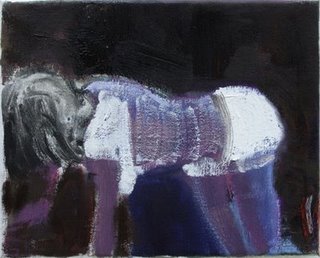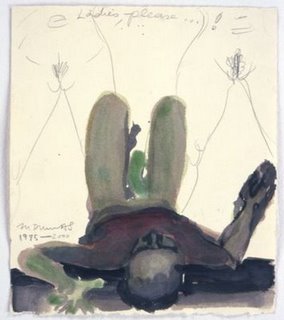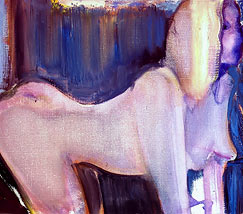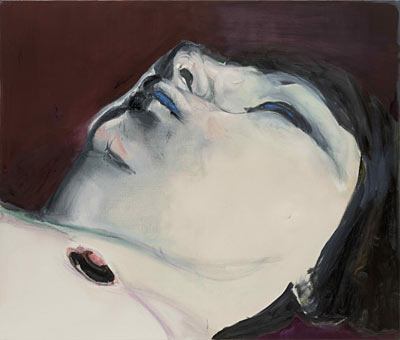Who would have predicted, twenty years ago, when painting had been pronounced "dead" and figure painting deader still, if that were possible, that today the world's hottest-selling woman artist would be a painter--and a figure painter, at that? This thought arose as I spent time, recently, at the current mid-career exhibition of the work of the South African painter, Marlene Dumas, at the Museum of Contemporary Art in Los Angeles.
"Hottest-selling" means nothing, of course, in aesthetic terms. But I was moved by Dumas' unremitting, sometimes painful, always pitiless examination of the human body and the human face. As those who follow my blog entries know, I have written recently about Don Bachardy's work with the figure, about sitting for Bachardy, and have attempted my own "self-portrait" in words, so this topic has been much on my mind. In this context, I saw all of Dumas' work to be "self-portrait", even though none of it actually is. I believe that in looking at others with the kind of intensity her painting requires, Dumas is in some sense looking into the mirror and casting a penetrating gaze into her own humanity.
Given this subject matter, it's hardly surprising that her work hews closely to the classical, timeless "eros and thanatos" theme. Erotic the work certainly is, with its focus on (mainly) feminine sexuality, and the beauty--and vulnerability--of the female form: naked, often provocatively posed, sometimes mercilessly exposed to the voyeur's gaze.
Here and there, a male figure in a state of unambiguous arousal adds edge and context to the female sexuality.
Dumas' figures are palpitatingly alive, brimming with energy, desire, emotional complexity... We feel their flesh.
And yes, what would eros be without its counterpart, thanatos, the shadow of death?
Dumas titles her show, tellingly, "Measuring Your Own Grave." In the poetic artist's statement included in the materials accompanying the show, she offers this explanation for the "somber title":
It is the best definition I can find
for what an artist does when making art
and how a figure in a painting makes its mark.
She shows us human flesh, post mortem, laid out, cold and blue, deprived of the life force that once activated it. She paints death masks,-the faces, I assume, of loved ones, or those who have a special meaning for her--as though to experience for herself the state of death, as much as to make a record of it.
Is it redundant to point out, yet again, that the flesh is mortal? That it is the source of the deepest--and most fleeting--of our pleasures (remember, the French call sexual climax a "petite mort", a little death?) as well as the most profound of our insecurities and fears? Perhaps. It has been done more times by poets and painters than anyone would care to count. And yet... here comes Marlene Dumas to do it for us one more time, in a way that no other human being ever has or ever will, and I for one am moved again to the contemplations of our shared mortality and, in particular, of my own. This is the ultimate teaching of the Buddha: the absolute knowledge that we all will die. It is well to be reminded of it, to keep it "in mind," if we wish to lead a fully conscious and compassionate life.
(As I was jotting these last words down, on a bench outside the market as I waited for Ellie to finish the shopping chores, a rather old, old man with grizzled beard stopped by to leer at me and offer a heavy sigh. "These women today," he said, a propos of nothing--and everything--"they don't wear bras any more." He used his age worn hands to describe, achingly, what he had seen. "You're still watching, then?" I asked, amused by his ancient, unapologetic lechery. "At my age," he told me with another big sigh, "that's all I can do." And chuckled wearily, and moved on.)
Ah, eros! Ah, thanatos! We humans are so obsessively attached to each of them... No?
Our 2024 Coverage Needs You
It's Another Trump-Biden Showdown — And We Need Your Help
The Future Of Democracy Is At Stake
Our 2024 Coverage Needs You
Your Loyalty Means The World To Us
As Americans head to the polls in 2024, the very future of our country is at stake. At HuffPost, we believe that a free press is critical to creating well-informed voters. That's why our journalism is free for everyone, even though other newsrooms retreat behind expensive paywalls.
Our journalists will continue to cover the twists and turns during this historic presidential election. With your help, we'll bring you hard-hitting investigations, well-researched analysis and timely takes you can't find elsewhere. Reporting in this current political climate is a responsibility we do not take lightly, and we thank you for your support.
Contribute as little as $2 to keep our news free for all.
Can't afford to donate? Support HuffPost by creating a free account and log in while you read.
The 2024 election is heating up, and women's rights, health care, voting rights, and the very future of democracy are all at stake. Donald Trump will face Joe Biden in the most consequential vote of our time. And HuffPost will be there, covering every twist and turn. America's future hangs in the balance. Would you consider contributing to support our journalism and keep it free for all during this critical season?
HuffPost believes news should be accessible to everyone, regardless of their ability to pay for it. We rely on readers like you to help fund our work. Any contribution you can make — even as little as $2 — goes directly toward supporting the impactful journalism that we will continue to produce this year. Thank you for being part of our story.
Can't afford to donate? Support HuffPost by creating a free account and log in while you read.
It's official: Donald Trump will face Joe Biden this fall in the presidential election. As we face the most consequential presidential election of our time, HuffPost is committed to bringing you up-to-date, accurate news about the 2024 race. While other outlets have retreated behind paywalls, you can trust our news will stay free.
But we can't do it without your help. Reader funding is one of the key ways we support our newsroom. Would you consider making a donation to help fund our news during this critical time? Your contributions are vital to supporting a free press.
Contribute as little as $2 to keep our journalism free and accessible to all.
Can't afford to donate? Support HuffPost by creating a free account and log in while you read.
As Americans head to the polls in 2024, the very future of our country is at stake. At HuffPost, we believe that a free press is critical to creating well-informed voters. That's why our journalism is free for everyone, even though other newsrooms retreat behind expensive paywalls.
Our journalists will continue to cover the twists and turns during this historic presidential election. With your help, we'll bring you hard-hitting investigations, well-researched analysis and timely takes you can't find elsewhere. Reporting in this current political climate is a responsibility we do not take lightly, and we thank you for your support.
Contribute as little as $2 to keep our news free for all.
Can't afford to donate? Support HuffPost by creating a free account and log in while you read.
Dear HuffPost Reader
Thank you for your past contribution to HuffPost. We are sincerely grateful for readers like you who help us ensure that we can keep our journalism free for everyone.
The stakes are high this year, and our 2024 coverage could use continued support. Would you consider becoming a regular HuffPost contributor?
Dear HuffPost Reader
Thank you for your past contribution to HuffPost. We are sincerely grateful for readers like you who help us ensure that we can keep our journalism free for everyone.
The stakes are high this year, and our 2024 coverage could use continued support. If circumstances have changed since you last contributed, we hope you'll consider contributing to HuffPost once more.
Already contributed? Log in to hide these messages.




